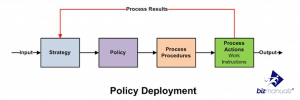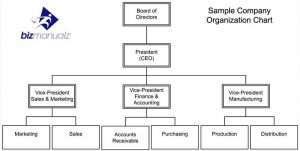Is a Policy First or Procedure First?

In any organization, policies and procedures play a crucial role in ensuring that the business runs smoothly. But the question remains, which one should come first? Is it better to establish policies before procedures, or should procedures be developed first? In this article, we’ll explore the definitions of policies and procedures, the importance of both, and the benefits and drawbacks of a policy-first or procedure-first approach. Is a policy first or procedure first?
Understanding Policies and Procedures
When it comes to running a successful organization, having clear and well-defined policies and procedures is essential. These guidelines help to establish a framework for how employees should conduct themselves and work towards the goals of the company. In this article, we will dive deeper into the definitions of policies and procedures and explore why they are so important.
Definition of Policies

Business Policy Deployment includes your strategy, policies, procedures, and work instructions.
Policies are the backbone of any organization. They are the guidelines that help to ensure that everyone is on the same page and working towards the same goals. Policies can cover a wide range of topics, including ethics, employee conduct, and the overall direction of the company. They are typically established by upper management and are designed to be followed by all employees.
For example, a company may have a policy that prohibits employees from using company resources for personal gain. This policy would outline what constitutes personal use and what the consequences would be for violating the policy. By having this policy in place, employees know what is expected of them and can avoid any potential misunderstandings.
Definition of Procedures
While policies provide the overarching guidelines for an organization, procedures focus on the specific steps or actions that are necessary to achieve a specific goal. They outline the specific processes and actions taken to complete a task. Procedures often come after policies are established and are more tactical in nature.
For example, a company may have a policy that requires all employees to complete a performance review every six months. The procedure for completing the performance review may include steps such as setting goals, completing a self-assessment, and meeting with a supervisor to discuss performance. By having a clear procedure in place, employees know exactly what they need to do to complete the performance review successfully.
Overall, policies and procedures are essential for any organization that wants to operate efficiently and effectively. By having clear guidelines in place, employees know what is expected of them and can work towards the goals of the company with confidence.
The Importance of Policies and Procedures
Policies and procedures are the backbone of any well-structured organization. They provide a framework for decision-making and ensure that tasks are completed in a consistent and efficient manner. In this way, policies and procedures help to establish a clear organizational structure, which is essential for any successful business.
Establishing Organizational Structure
One of the primary functions of policies and procedures is to establish organizational structure. Policies set the tone and direction of a company, outlining its goals and objectives. Procedures, on the other hand, ensure that tasks are completed in a consistent and efficient manner. Together, policies and procedures create a clear framework for decision-making, which is essential for any business to function effectively.
For example, a policy might outline the company’s commitment to customer service, while a procedure would detail the steps that employees must follow when dealing with customer complaints. This ensures that all employees are working towards the same goal, and that customers receive consistent and high-quality service.
Ensuring Compliance and Consistency
Another important function of policies and procedures is to ensure compliance and consistency. Without policies and procedures in place, organizations risk inconsistency in their processes and operations. These inconsistencies can lead to confusion among employees, decreased productivity, and potential legal issues.
For example, without a clear policy on data privacy, employees might handle sensitive information in different ways, leading to breaches and legal consequences. By establishing clear policies and procedures around data privacy, organizations can ensure that all employees are following the same guidelines, reducing the risk of data breaches and legal issues.
Enhancing Employee Performance
Well-established policies and procedures can also enhance employee performance. By setting clear expectations and outlining the steps necessary to complete tasks, employees can work more confidently and efficiently. This leads to increased job satisfaction and a sense of empowerment.
For example, a clear procedure for onboarding new employees can help them to feel more confident and prepared in their new role. This can lead to increased productivity and job satisfaction, as well as a lower turnover rate.
In conclusion, policies and procedures are essential for any well-functioning organization. They provide a clear framework for decision-making, ensure compliance and consistency, and enhance employee performance. By establishing clear policies and procedures, organizations can create a strong foundation for success.
Policy-First Approach

Organizational Leadership
A policy-first approach is a management strategy that prioritizes the creation and implementation of policies as a means of establishing a clear direction for the company. By setting rules and guidelines, a policy-first approach ensures that everyone is working towards the same goals and that all employees understand what is expected of them.
Benefits of a Policy-First Approach
One of the key benefits of a policy-first approach is that it helps to maintain consistency across the organization. By establishing clear guidelines, policies help to ensure that all employees are following the same procedures and protocols. This can be particularly important for businesses that operate in regulated industries, where compliance with government regulations is essential.
Another benefit of a policy-first approach is that it can help to reduce confusion and ambiguity. When policies are clearly defined and communicated to employees, there is less room for interpretation or misunderstanding. This can help to minimize mistakes and errors, which can ultimately save time and money for the company.
Potential Drawbacks of a Policy-First Approach
Despite its benefits, a policy-first approach can also have some potential drawbacks. One of the main criticisms of this approach is that it can be seen as inflexible. Because policies are often created at a high level and applied uniformly across the organization, they may not take into account the specific needs of different departments or employees. This can lead to resistance to change and a lack of buy-in from employees, which can ultimately undermine the effectiveness of the policies.
Another potential drawback of a policy-first approach is that it can be time-consuming and expensive to create and implement policies. Developing policies requires significant resources, including time, money, and expertise. In addition, policies may need to be updated and revised periodically to reflect changes in the business environment or regulatory landscape.
Examples of Policy-First Organizations
Government agencies and large corporations often have a policy-first approach. These organizations typically have strict guidelines in place to ensure compliance with regulations and to maintain consistency across the organization.
For example, the Environmental Protection Agency (EPA) has a wide range of policies in place to regulate activities related to air and water pollution, hazardous waste, and other environmental issues. Similarly, companies like Walmart and McDonald’s have extensive policies related to employee training, safety, and customer service.
Overall, a policy-first approach can be an effective way to establish clear guidelines and expectations for employees. However, it is important to balance the benefits of policies with the potential drawbacks, and to ensure that policies are developed and implemented in a way that takes into account the specific needs and circumstances of the organization.
Procedure-First Approach
A procedure-first approach is a method of completing tasks that focuses on the specific steps necessary to complete a task. This approach can be more flexible and can allow different departments or employees to develop their own processes that work best for them. By focusing on the procedures, this approach can help to ensure that tasks are completed in a consistent and efficient manner.
Benefits of a Procedure-First Approach
One of the main benefits of a procedure-first approach is that it allows for more flexibility. With a focus on procedures rather than policies, different departments or employees can develop their own processes that work best for their specific needs. This can help to increase efficiency and productivity, as employees are able to work in a way that suits them best.
Another benefit of a procedure-first approach is that it can help to identify areas for improvement. By breaking down tasks into their individual steps, it becomes easier to identify areas where processes can be streamlined or improved. This can help to increase efficiency and reduce costs.
Potential Drawbacks of a Procedure-First Approach
However, a procedure-first approach can also have potential drawbacks. One of the main drawbacks is that it can lack overall direction. Without clear policies guiding procedures, departments may work in silos, which can lead to inconsistencies and inefficiencies. This can be particularly problematic for larger organizations, where departments may be more disconnected from each other.
Another potential drawback of a procedure-first approach is that it may not result in a cohesive strategy for the organization. While procedures can be effective at a departmental level, they may not be aligned with the overall goals of the organization. This can lead to a lack of coordination and a lack of focus on the bigger picture.
Examples of Procedure-First Organizations
Small businesses and startups often have a procedure-first approach. They may not have strict policies in place, but focus on establishing processes that work for their specific needs. This can help them to be more agile and responsive to changes in the market.
However, larger organizations can also benefit from a procedure-first approach. By breaking down tasks into their individual steps, it becomes easier to identify areas where processes can be streamlined or improved. This can help to increase efficiency and reduce costs, which can be particularly important for larger organizations that have to manage more complex processes.
Overall, a procedure-first approach can be an effective way to complete tasks, particularly for smaller organizations or departments. However, it is important to balance this approach with clear policies and a focus on the overall goals of the organization to ensure that procedures are aligned with the bigger picture.
Policy First or Procedure First
Ultimately, whether a policy-first or procedure-first approach is best for an organization depends on its specific needs. Both policy and procedure approaches have their benefits and drawbacks, and finding the right balance is key to creating a cohesive strategy that aligns with the organization’s goals.















Leave a Reply